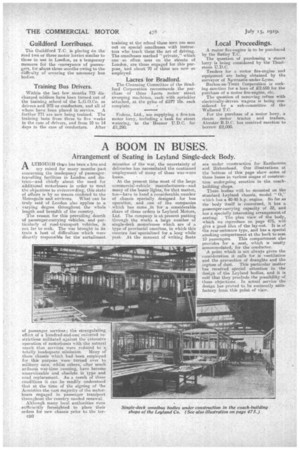A BOOM IN BUSES.
Page 8

If you've noticed an error in this article please click here to report it so we can fix it.
Arrangement of Seating in Leyland Single-deck Body.
ALTHOUGII thare has been a hue and cry raised for many months past concerning the inadequacy of passengertravelling facilities in London and district—and chiefly about the need for additional motorbuses in order to meet the objections to overcrowding, this state of affairs is by no means confined to the Metropolis and environs. What can be truly said of London also applies to a varying degree throughout the whole length. and breadth of the country. The reason for this prevailing dearth of passenger-carrying vehicles, and particularly of road-transport vehicles, is not far to seek. The wax brought in its train a host of difficulties which were directly responsible for the curtailment of passenger services; the strangulating effect of a hundred-and-one eniorced restrictions militated against the extensive operation of motorbuses with the natural result that services were reduced to aa totally inadequate minimum. Many of those chassis which had been employed for this purpose were turned over to military uses, whilst others; after much arduous war-time running, have become unserviceable and obsolete in type and need replacement. Aa a result of these • conditions it can be readily understood that at the time of the signing of ',Ise Armistice the vast majority of the rt-a4orbuses engaged in passenger transport throughout the country needed renewal.
Although many local authorities were snfficiently foresighted to place their orders ftir new chassis prior to the ter 030 mination of the war, the uncertainty of deliveries has necessitated the continued employment of many of these war-worn buses.
At the present time most of the large commercial-vehicle manufacturers—and many of the lesser lights, for that matter, too—have in hand a considerable number of chassis specially designed for bus operation, and one of the companies which has come in for a considerable share of these orders is Leyland Motors, Ltd. The company is at present putting through the svorks a large number of single-deck motorbuses which are oi type of provincial omnibus, in which this concern has specialized for .a, long while past. At the moment of writing fleets
are under construction for Eastbourne and Birkenhead. Our illustrations at the bottom of this page show some of these buses in various stages of construction undergoing erection in the coachbuilding shops. These bodies will be mounted on the standard Leyland chassis, model -" 0," which has a 40-48 h.p. engine. So far as the body itself is concerned, it has a passenger-carrying capacity of 32, and has a. specially interesting arrangement of seating. The plan view of the body, which we r'eprocluce on page 475, will give a good idea of the lay-out It is of the rear-entrance type, and has a special smoking compartment at the back to seat 10 passengers. This compartment also provides for a seat, which is neatly accommodated, for the conductor.
A point which is not always given the consideration it calls for is ventilation and the prevention of draughts and the ingress of dust. This particular matter ha received special attention in the design of the Leyland bodies, and it is said that they preclude the possibility of these objections. In actual service the design hasproved to be eminently satisfactory from this point of view.






















